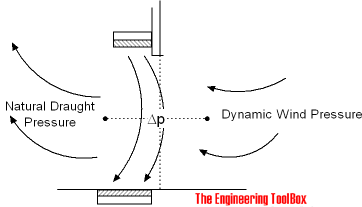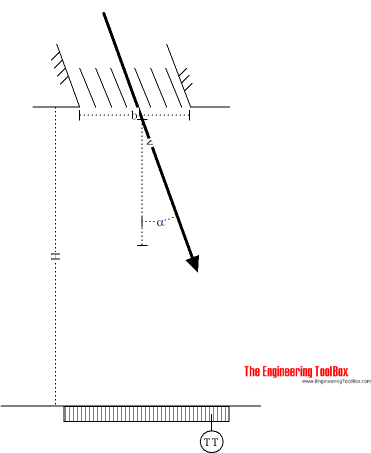Air Curtains or Air Screens
Calculate air curtains or air screens in open doorways used to keep acceptable indoor comfort in buildings.
Air curtains and air screens blows heated air (or cooled air in summertime) across door openings and reduces the ingress of cold air (or hot air in summertime) from the outside due to wind forces and natural draught through the building.
- Air screens acts with heated (or cooled) air
- Air curtains acts with unheated (or not cooled) air
Actual Applications
- Door-less shop fronts
- Workshop entrances
- Doors of public buildings which are frequently opened
Actual Designs
- Vertically mounted - on one or both sides of the opening
- Horizontally mounted - on top, bottom or both top and bottom of the opening

Forces acting on an opening in the wall
The forces acting on an opening like a door into a warehouse, mall or similar can be summarized to
- wind
- natural draught
The natural draught depends on the height of the building (open inside height) and the temperature difference between outside and inside air. The differential pressure due to natural draught in a building doorway with inside temperature 20oC, outside temperature 0oC and building height 10 m is approximately 10 Pa. With -20oC and a building height of 20 m the natural draught pressure is close to 40 Pa.
The wind force acting on an opening in a wall is proportional to mass times velocity squared. The pressure at 10 m/s (36 km/h, 22 mph, Beaufort Fresh Breeze ) is 60 Pa.
Air Velocities
By directing the airflow an angle out of the opening the natural draught and wind forces can be resisted. The "strength" of the air curtain follows the formula
- mass times velocity squared
An air curtain blowing twice the speed has four times the resisting power with the same air volume.
In general the discharge velocities should not exceed
- discharge from above > 5 - 15 m/s (15 - 50 ft/s)
- discharge from below > 2 - 5 m/s (5 - 15 ft/s)
- discharge from side > 10 - 15 m/s (30 - 50 ft/s)
Note that maximum discharge velocities depends on location of the discharge nozzles. The discharge velocity must be increased if the air curtain unit is mounted higher for the air stream to hit the floor with the required velocity to stabilize the air stream.
For ware houses, shopping malls and similar buildings with openings up to 2.5 m the velocity should not exceed 5 - 9 m/s. For industrial buildings the velocity can be exceeded to 35 - 40 m/s.
Air Volume
The air volume required depends on many variables and an exact calculation may often be hard to perform. Values of 2000 - 5000 m3/h air per m2 door opening are common.
Note! Exposed systems with
- lots of wind
- lower out-door temperatures
- higher buildings
may even double the values.
Air Flow and the Potential Differential Pressure

The "strength" of an air curtain is the maximum potential differential pressure it can resist. The potential pressure resistance generated by an airflow through an inlet opening can be expressed as
Δp = 2.2 q2 sin(α) / b H3/4 (1)
where
Δp = potential differential pressure over the opening in the wall (Pa, N/m2)
q = air flow through discharge nozzle (m3/s per meter opening width in wall)
α = airflow angle (normally between 20 - 30o)
b = depth of discharge nozzle (m)
H = height of door opening (m)
The average air velocity through the discharge nozzle can be calculated as
v = q / b (2)
where
v = average velocity (m/s)
Note! The average air velocity is per meter opening width in wall. The velocity should not exceed the values mentioned above.
Air Curtains Calculator
The calculator below can be used to estimate the strength of an air curtain by calculating the pressure difference and velocity in the air flow. Replace the default values with the actual values.
The differential pressure compensates the differential pressure caused by the natural draught and the wind velocity.
Example - Air Curtain
The height of an entrance opening to a shopping-mall is 2.5 m. The depth of the entrance is 1 m. The air flow angle through the entrance is 25 degrees and the air flow per meter width of the opening is 8 m3/s.
The force against natural draught and wind forces can be calculated with (1) as
Δp = 2.2 (8 m3/s)2 sin(25) / 1 (2.5 m)3/4
= 29.9 Pa
The velocity through the inlet can be calculated with (2) as
v = (8 m3/s) / (1 m)
= 8 m/s
Modulating Air Curtains
The forces we tries to compensate with air curtains constantly varies with outside temperature and wind velocity and some sort of control device modulating the air flow angle and air flow volume may be required.
- with outside temperatures close to inside temperatures and lower wind velocities - the air flow in the curtain is minimized and the air flow is directed straight through the doorway
- with outside temperatures far from inside temperatures - and lots of wind - the air flow in the curtain is maximized and the air flow is directed out of the doorway
A modulated control can be achieved with one or more temperature transmitters located as indicated in the figure above.
Discharge temperatures (winter conditions)
Air curtain discharge temperatures should be kept within certain limits. For winter conditions
- smaller systems - within temperature range 35 - 50oC (95 - 125oF)
- larger systems - within temperature range 25 - 35oC (80 - 95oF)
- suction temperature - within temperature range 5 - 15oC (40 - 60oF)
Related Topics
-
Ventilation Systems
Design of systems for ventilation and air handling - air change rates, ducts and pressure drops, charts and diagrams and more.
Related Documents
-
Beaufort's Wind Scale
The Beaufort description and observation scale for wind and wind speed. -
Dynamic Pressure
Dynamic pressure is the kinetic energy per unit volume of a fluid in movement. -
Natural Draft - Air Flow Volume and Velocity
Air flow - volume and velocity - due to stack or flue effect caused by indoor hot and outdoor cold temperature difference. -
Wind Load vs. Wind Speed
Wind load on surface - Wind load calculator.




